Study on Design and Deformation Law of Pile-Anchor Support System in Deep Foundation Pit
Abstract
:1. Introduction
2. Deep Foundation Pit Excavation Monitoring and Support Scheme Design
2.1. Engineering Geological Condition
2.2. Surroundings around the Foundation Pit
2.3. Design of Foundation Pit Support Scheme
- —Passive earth pressure and fulcrum force to the bending moment of the pile bottom; the fulcrum force in this paper takes the smaller value of the anchoring force and the tensile force of the anchor;
- —Bending moment of active earth pressure on the pile bottom.
- δ—Upward displacement of the foundation pit bottom (mm);
- n—Soil layers from top to bottom of the foundation pit;
- —The gravity of the i-layer soil (kN/m3);
- —The thickness of the i-layer soil (m);
- q—Ground overload on the top of the foundation pit (kPa);
- D—Pile embedding length (m);
- H—Excavation depth (m);
- c—Soil cohesion at the pile bottom (kPa);
- —Internal friction angle of the soil layer at the pile bottom (°);
- —Weighted average weight of soil layers from top to bottom of the pile (kN/m3).
2.4. Excavation Steps of Foundation Pit
3. Deep Foundation Pit Monitoring
3.1. Monitoring Equipment
3.2. Monitoring System Layout
4. Analysis of Monitoring Results
4.1. Horizontal Displacement Analysis
4.2. Analysis of Prestressed Anchor
5. Conclusions
- i.
- The maximum horizontal displacement of the supporting pile was less than the design value, and the maximum horizontal displacement was not at the top of the pile.
- ii.
- The loss of anchor axial force was relatively large in the initial stage of prestressed tensioning and locking. With the deepening of the excavation of the foundation pit, the lateral pressure of the stratum gradually increased, and the anchor prestress showed an increasing trend until the end of the excavation, and then tended to be stable. Most of the measured prestressed bolt tension locking value was less than 50% of the design locking value, and the axial force of the bolt only fluctuated and was lost during the excavation construction period, and there was no obvious increase. After the excavation of the foundation pit was completed, it gradually became stable. It can be seen that the design value of the axial force of the prestressed bolt in this project was conservative.
- iii.
- Throughout the excavation process of the foundation pit, the stress change of the prestressed anchor could be roughly divided into the prestress loss stage, the fluctuation change stage, and the stability stage. The prestress loss stage is mainly a period after the anchor tension locking, the fluctuation stage is mainly the foundation pit excavation stage and the lower anchor tension load change period, and the stability stage is mainly the foundation pit excavation completed and foundation construction stage.
- iv.
- The axial force of prestressed anchor varied with the formation pressure and surrounding load. The tension of the lower anchor had a certain influence on the axial force of the upper anchor. Except for the east side of the foundation pit, the anchors of the first layer were all stabilized at about 140 kN, and the anchors of the second layer were stabilized at about 150 kN. The third row of anchors on the north side was stable at around 170 kN.
- v.
- The application of information construction technology can compare and analyze the monitoring data, geological structure, groundwater distribution, and other information collected during the construction with the original design plan, evaluate the scientificity of the previous construction, and predict the possible situations in the next construction, as well as analyze and give reasonable suggestions to guide the construction design to achieve the purpose of dynamic optimization. This study analyzed the variation law of stress and deformation of foundation pit supporting structure, improved the timeliness of data during construction, and provides a reference for information construction of related working conditions.
Author Contributions
Funding
Institutional Review Board Statement
Informed Consent Statement
Data Availability Statement
Conflicts of Interest
References
- Zeng, F.; Li, M.; Chen, J.; Wang, J. Development and application of a system for dynamic and synchronous analysis of both monitor data and construction information in foundation Pit groups. J. Shanghai Jiaotong Univ. 2017, 51, 269. [Google Scholar]
- Li, J.-P.; Chen, H.-H.; Li, L.; Ma, J.-S. Observation on depth and spatial effects of deep excavation in soft clay. China J. Highw. Transp. 2018, 31, 208. [Google Scholar]
- Liu, B. Measurement and analysis of deformation of adjacent strata super deep and large foundation pits in Lujiazui District of Shanghai. Yantu Gongcheng Xuebao/Chin. J. Geotech. Eng. 2018, 40, 1950–1958. [Google Scholar]
- Xu, S.-F.; Zhou, Q.-H.; Zheng, W.-H.; Zhu, Y.-Q.; Wang, Z. Influences of construction of foundation pits on deformation of adjacent operating tunnels in whole process based on monitoring data. Yantu Gongcheng Xuebao/Chin. J. Geotech. Eng. 2021, 43, 804–812. [Google Scholar]
- Shi, L.; Xue, Y.; Zhang, L.; Xue, Z. Monitoring and Analysis of Deep Foundation Pit Construction of Structural Loess in Northwest China. IOP Conf. Ser. Earth Environ. Sci. 2021, 719, 032001. [Google Scholar] [CrossRef]
- Sun, H.; Chen, Y.; Zhang, J.; Kuang, T. Analytical investigation of tunnel deformation caused by circular foundation pit excavation. Comput. Geotech. 2019, 106, 193–198. [Google Scholar] [CrossRef]
- Wang, H.-X.; Li, X.-Q.; Yang, S.-F. Nonlinear soil spring model and parameters for calculating deformation of enclosure structure of foundation pits. Chin. J. Geotech. Eng. 2020, 42, 1032–1040. [Google Scholar]
- Guo, P.; Gong, X.; Wang, Y. Displacement and force analyses of braced structure of deep excavation considering unsymmetrical surcharge effect. Comput. Geotech. 2019, 113, 103102. [Google Scholar] [CrossRef]
- Yang, J.; Kong, D. Deformation of deep and large foundation pit in soft soil of Fuzhou Subway. Arab. J. Geosci. 2020, 13, 36. [Google Scholar] [CrossRef]
- Luo, J.; Ren, R.; Guo, K. The deformation monitoring of foundation pit by back propagation neural network and genetic algorithm and its application in geotechnical engineering. PLoS ONE 2020, 15, e0233398. [Google Scholar] [CrossRef]
- Hu, D.; Guo, C.; Chu, X. Hysteretic characteristic curve monitoring and finite element analysis in nondestructive testing of fabricated foundation pit. Russ. J. Nondestruct. Test. 2020, 56, 752–764. [Google Scholar]
- Lin, H.; Gao, Y.; Du, J.; Wang, Y.; Shi, H. Application of rigid large-diameter cement-soil mixing pile support technology in a deep foundation pit project. Fresenius Environ. Bull. 2021, 30, 4429–4435. [Google Scholar]
- Peck, R.B. Deep Excavations and Tunneling in Soft Ground. In Proceedings of the 7th ICSMFE, Mexico City, Mexico, 29 August 1969. [Google Scholar]
- Briaud, J.L.; Iii, W.; Weatherby, D. Should Grouted Anchors Have Short Tendon Bond Length? J. Geotech. Geoenviron. Eng. 1998, 124, 110–119. [Google Scholar] [CrossRef]
- Woods, R.I.; Barkhordari, K. The influence of bond stress distribution on ground anchor design. In Proceedings of the International Conference Organized by the Institution of Civil Engineers, London, UK, 20–21 March 1997. [Google Scholar]
- Wu, X.; Ghaboussi, J.; Garrett, J.H., Jr. Use of neural networks in detection of structural damage. Comput. Struct. 1992, 42, 649–659. [Google Scholar] [CrossRef]
- Chen, W. Research on safety and environmental protection control methods based on underground and foundation pit engineering. Fresenius Environ. Bull. 2020, 29, 10832–10839. [Google Scholar]
- Zhou, Y.; Li, C.; Ding, L.; Sekula, P.; Love, P.E.; Zhou, C. Combining association rules mining with complex networks to monitor coupled risks. Reliab. Eng. Syst. Saf. 2019, 186, 194–208. [Google Scholar] [CrossRef]
- Ko, H.; Baran, R.; Arozullah, M. Neural network based novelty filtering for signal detection enhancement. In Proceedings of the 35th Midwest Symposium on Circuits and Systems, Washington, DC, USA, 9–12 August 1992. [Google Scholar]
- Li, X.; Liu, X.; Li, C.Z.; Hu, Z.; Shen, G.Q.; Huang, Z. Foundation pit displacement monitoring and prediction using least squares support vector machines based on multi-point measurement. Struct. Health Monit. 2019, 18, 715–724. [Google Scholar] [CrossRef]
- Lv, J.; Hu, Z.; Ren, G.; Zhang, C.; Liu, Y. Research on new FBG displacement sensor and its application in Beijing Daxing Airport project. Optik 2019, 178, 146–155. [Google Scholar] [CrossRef]
- Wu, Y.Q.; Zhu, Y.P. Monitoring and numerical simulation of deformation law of deep foundation pit of subway station in Lanzhou collapsible loess. Yantu Gongcheng Xuebao/Chin. J. Geotech. Eng. 2014, 36, 404–411. [Google Scholar]
- Wang, S.; Liu, J.; Geng, L.; Shen, L. Numerical analysis on frost heave deformation and control for retaining system of deep foundation pit. Tumu Gongcheng Xuebao/China Civ. Eng. J. 2018, 51, 122–128. [Google Scholar]
- Xiao, Z.; Li, M.; Wang, D.; Chen, J. Test and Analysis of Deformation Characteristics of Deep Foundation Pit in Residual Soil Under Rainfall. J. Shanghai Jiaotong Univ. 2020, 54, 873. [Google Scholar]
- Zhou, Y.; Liu, K.; Wang, F. Research on the Mechanical Properties of New Double-Row Pile Supporting Structure Based on an In Situ Study. Shock. Vib. 2021, 2021, 5177777. [Google Scholar] [CrossRef]
- Zhigang, T.; Chun, Z.; Yong, W.; Jiamin, W.; Manchao, H.; Bo, Z. Research on Stability of an Open-Pit Mine Dump with Fiber Optic Monitoring. Geofluids 2018, 2018, 9631706. [Google Scholar] [CrossRef]
- Huang, Z.; Mao, C.; Guan, S.; Tang, H.; Liu, Z. Simulation research on the deformation safety monitoring and evaluation algorithm of coastal soft foundation pit based on big data. Soft Comput. 2021, 1–12. [Google Scholar] [CrossRef]
- Ding, Z.; Jin, J.; Han, T.-C. Analysis of the zoning excavation monitoring data of a narrow and deep foundation pit in a soft soil area. J. Geophys. Eng. 2018, 15, 1231–1241. [Google Scholar] [CrossRef]
- Zhu, C.; Yan, Z.; Lin, Y.; Xiong, F.; Tao, Z. Design and application of a monitoring system for a deep railway foundation pit project. IEEE Access 2019, 7, 107591–107601. [Google Scholar] [CrossRef]
- Huang, X.; Wang, Y.; Sun, Y.; Zhang, Q.; Zhang, Z.; You, Z.; Ma, Y. Research on horizontal displacement monitoring of deep soil based on a distributed optical fibre sensor. J. Mod. Opt. 2018, 65, 158–165. [Google Scholar] [CrossRef]
- Wang, S.; Li, Q.; Dong, J.; Wang, J.; Wang, M. Comparative investigation on deformation monitoring and numerical simulation of the deepest excavation in Beijing. Bull. Eng. Geol. Environ. 2021, 80, 1233–1247. [Google Scholar] [CrossRef]
- Lü, C.-Z.; Chen, B.; Hu, Y.-S. Environmental Impacts of the Abnormal Settlement of Surrounding Buildings Caused by Deep Pit Excavation in Shanghai. Ekoloji 2018, 27, 1337–1343. [Google Scholar]
- Wang, P.; Ma, S.; Yue, Z.; Lu, C.; Li, A. A theoretical study on the spatial effect of water-rich foundation pit instability failure. AIP Adv. 2021, 11, 015049. [Google Scholar] [CrossRef]
- Zheng, Y.; Hu, Z.; Ren, X.; Wang, R.; Long, Z. Effects of Partial Supporting Pile Removal from Deep Foundation Pits by Shallow Excavation Method in Loess Areas. Adv. Mater. Sci. Eng. 2021, 2021, 9934113. [Google Scholar] [CrossRef]
- Shen, Y.; Wang, D.; Lin, Y.; Tang, T.; Liu, X. On the effect of prevention measures against horizontal frost heave of foundation pits over winter. Rock Soil Mech. 2021, 42, 1434–1442. [Google Scholar]
- Lou, C.; Xia, T.; Liu, N. Spatial effects of deformation due to excavation in soft clay. Chin. J. Geotech. Eng. 2019, 41, 249–252. [Google Scholar]
- Gao, X.; Ding, J.H.; Wang, W.Y. Destech Publicat Inc. Study on Space Effect Coefficient of Deep Foundation Pit. In Proceedings of the 4th International Conference on Green Materials and Environmental Engineering (GMEE), Beijing, China, 28–29 October 2018. [Google Scholar]
- Liang, R.Z.; Wu, W.B.; Yu, F.; Jiang, G.S.; Liu, J.W. Simplified method for evaluating shield tunnel deformation due to adjacent excavation. Tunn. Undergr. Space Technol. 2018, 71, 94–105. [Google Scholar] [CrossRef]
- Liu, W.Z.; Li, T.X.; Wan, J.L. Deformation Characteristic of a Supported Deep Excavation System: A Case Study in Red Sandstone Stratum. Appl. Sci. 2022, 12, 129. [Google Scholar] [CrossRef]
- Ding, Z.; Zhang, X.; Jin, J.; Wang, L. Measurement analysis on whole excavation of foundation pit and deformation of adjacent metro tunnel. Rock Soil Mech. 2019, 40, 415–423. [Google Scholar]
- Sun, X.; Heng, C.; Zhou, Z.; Zhang, J. An empirical method for predicting ground surface settlement induced by metro station pit in Xiamen. China Civ. Eng. J. 2019, 2, 132–138. [Google Scholar]
- Huang, K.; Yang, W.; Qiang, M.; An, Y.-L.; Li, Y.; Zhou, J. Influence of Foundation Excavation Pit on Adjacent Metro Tunnel Using Fluid-solid Mechanics Theory. J. Cent. South Univ. (Sci. Technol.) 2019, 50, 198–205. [Google Scholar]
- Zhang, H.-D.; Liu, Z.; Li, Z.-Y. Case study of informative construction in deep excavation of subway stations. Chin. J. Geotech. Eng. 2008, 30, 441–446. [Google Scholar]
- Liu, J.; Xu, Z.; Yuan, F.; Guo, Z. Design and monitoring of foundation pit support project for pile foundation underpinning of abutment of interchange bridges. Chin. J. Geotech. Eng. 2019, 41, 217–220. [Google Scholar]
- Dariusz, S.; Jarosław, R. Role to be played by independent geotechnical supervision in the foundation for bridge construction. In IOP Conference Series: Materials Science and Engineering; IOP Publishing: Bristol, UK, 2017; p. 022073. [Google Scholar]
- Zhou, Y.; Ling, Y.-Q.; Yang, X.-H. Relationship between the displacement and stability of pile anchor retaining structure considering additional stress. Rock Soil Mech. 2018, 39, 2913–2921. [Google Scholar]
- Zhou, Y.; Wang, H.; Zhu, Y. Construction Mechanics Behavior Analysis of Pile-strut Supporting Structure of a Subway Deep Foundation Pit. J. Railw. Eng. Soc. 2019, 36, 86–92. [Google Scholar]
- Kozak, D.L.; Lafave, J.M.; Fahnestock, L.A. Seismic modeling of integral abutment bridges in Illinois. Eng. Struct. 2018, 165, 170–183. [Google Scholar] [CrossRef]
- Chen, A.X.; Wang, Q.; Chen, Z.D.; Chen, J.P.; Chen, Z.; Yang, J.A. Investigating pile anchor support system for deep foundation pit in a congested area of Changchun. Bull. Eng. Geol. Environ. 2021, 80, 1125–1136. [Google Scholar] [CrossRef]
- Zheng, G.; Lei, Y.; Cheng, X.; Li, X.; Wang, R. Influences and mechanisms of anchor failure on anchored pile retaining system of deep excavations J. Chin. J. Geotech. Eng. 2020, 42, 421–429. [Google Scholar]
- Han, J.Y.; Zhao, W.; Miao, L.H.; Jia, P.J.; Guan, Y.P. Three-Dimensional Numerical Parametric Investigation of the Influence of Large-Scale Overexcavation on Deep Excavations. In Proceedings of the 4th GeoShanghai International Conference on Advances in Soil Dynamics and Foundation Engineering, Shanghai, China, 27–30 May 2018; pp. 551–560. [Google Scholar]
- Perez, Z.A.; Schiavon, J.A.; Tsuha, C.D.C.; Dias, D.; Thorel, L. Numerical and experimental study on influence of installation effects on behaviour of helical anchors in very dense sand. Can. Geotech. J. 2018, 55, 1067–1080. [Google Scholar] [CrossRef]
- George, B.E.; Banerjee, S.; Gandhi, S.R. Helical Piles Installed in Cohesionless Soil by Displacement Method. Int. J. Geomech. 2019, 19, 04019074. [Google Scholar] [CrossRef]
- Dai, W.-K.; Liang, L.; Xin, Q.-M. Frost heaving model test and response analysis of pile-anchor foundation pit in cohesive soil area. J. Northeast. Univ. (Nat. Sci.) 2017, 38, 1785. [Google Scholar]
- Rahimi, M.; Tafreshi, S.N.M.; Leshchinsky, B.; Dawson, A.R. Experimental and numerical investigation of the uplift capacity of plate anchors in geocell-reinforced sand. Geotext. Geomembr. 2018, 46, 801–816. [Google Scholar] [CrossRef]
- Lei, G.; Guo, P.P.; Hua, F.C.; Gong, X.N.; Luo, L.N. Observed Performance and FEM-Based Parametric Analysis of a Top-Down Deep Excavation in Soil-Rock Composite Stratum. Geofluids 2021, 2021, 6964940. [Google Scholar] [CrossRef]
- Wang, T.F.; Liu, J.K.; Luo, Q.; Wang, Q.Z.; Zhang, L.; Qi, W. Calculation for Frost Jacking Resistance of Single Helical Steel Piles in Cohesive Soils. J. Cold Reg. Eng. 2021, 35, 06021001. [Google Scholar] [CrossRef]
- Liu, L.; Wu, R.; Congress, S.S.C.; Du, Q.; Cai, G.; Li, Z. Design optimization of the soil nail wall-retaining pile-anchor cable supporting system in a large-scale deep foundation pit. Acta Geotech. 2021, 16, 2251–2274. [Google Scholar] [CrossRef]
- Li, S.Z.; Ren, F.; Sheng, G.L.; Zhao, W.P. Three-dimensional numerical analysis of deformation of various combined support forms. In Proceedings of the 4th International Conference on Applied Materials and Manufacturing Technology (ICAMMT), Nanchang, China, 25–27 May 2018. [Google Scholar]

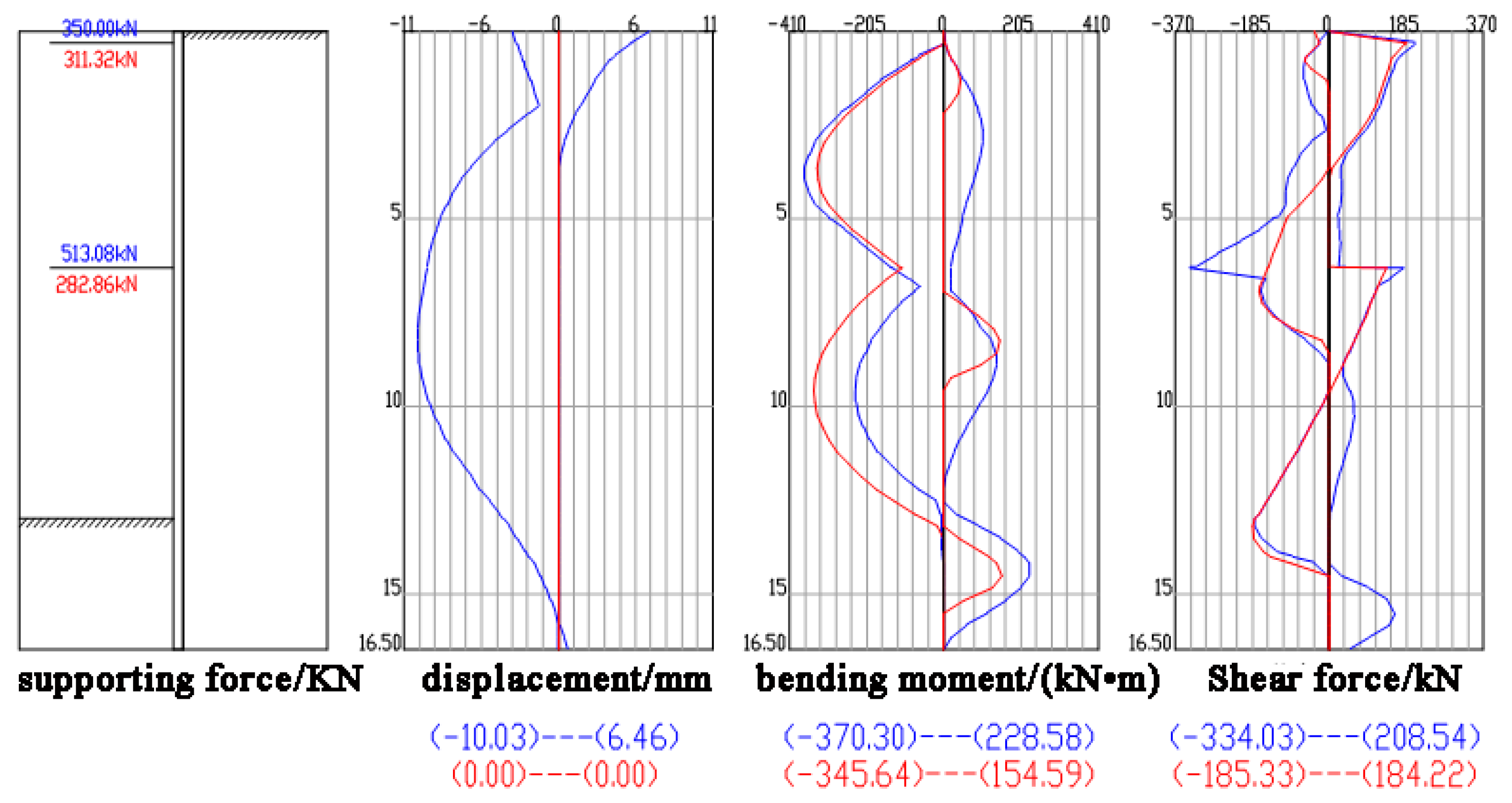
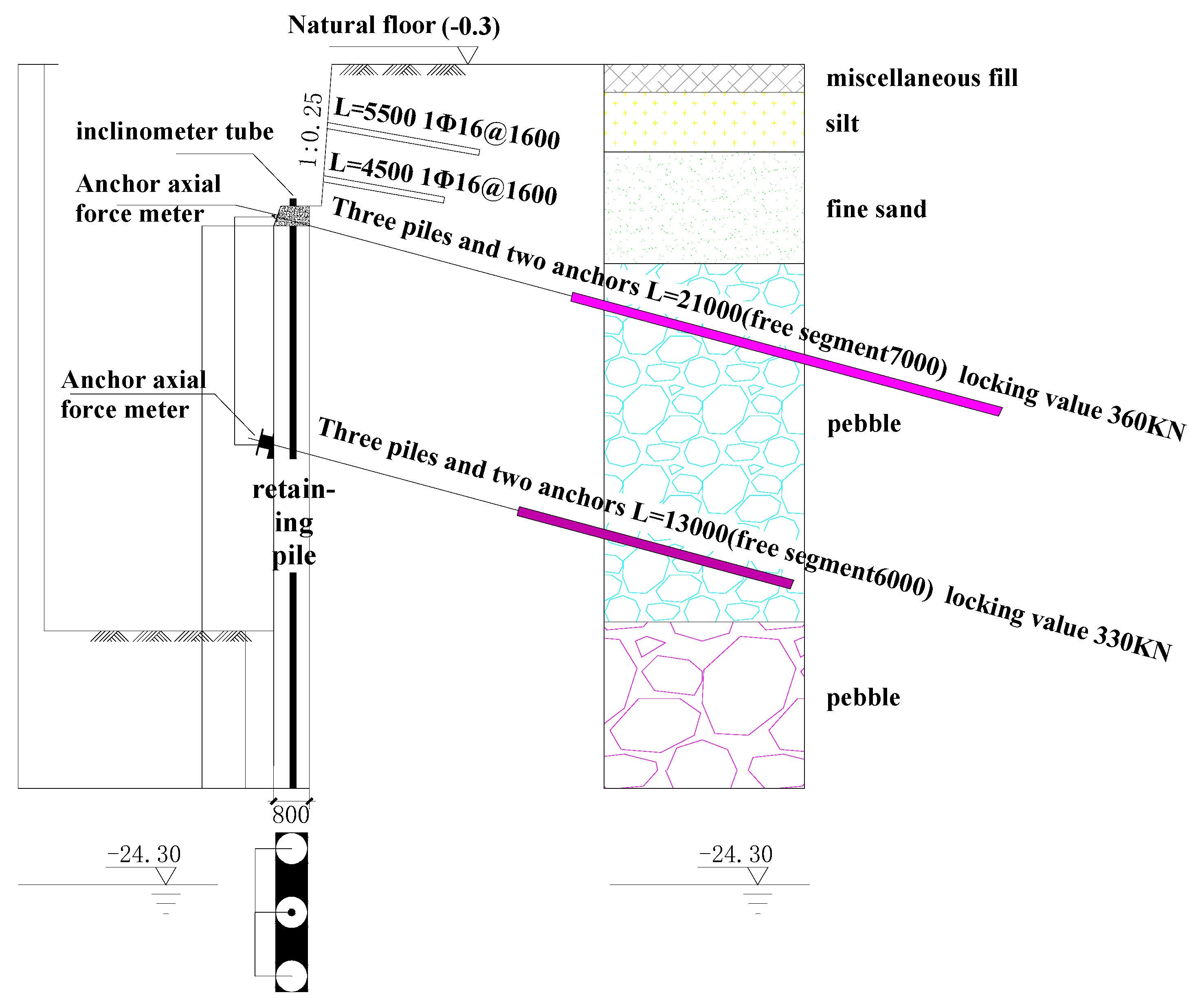
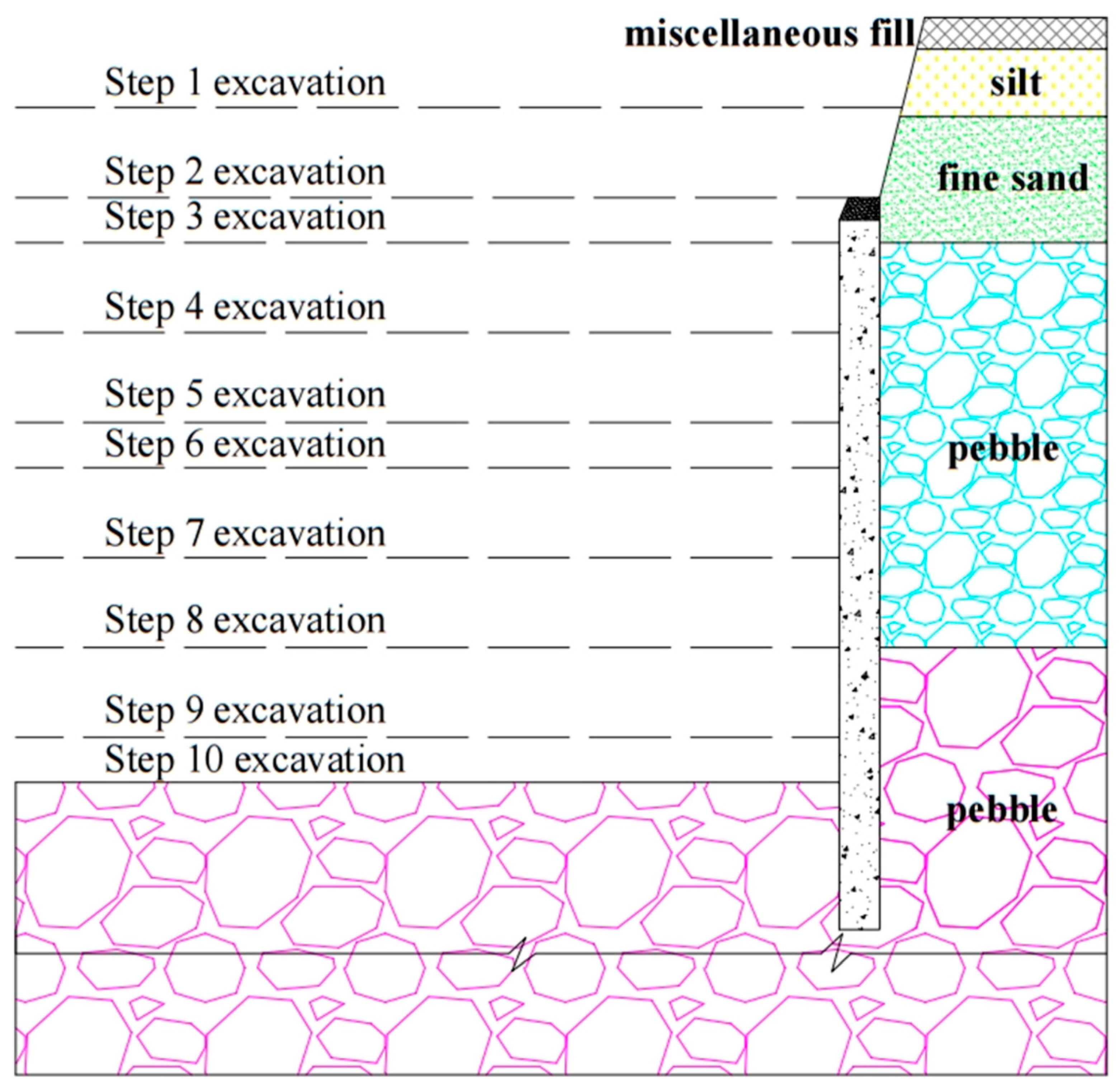
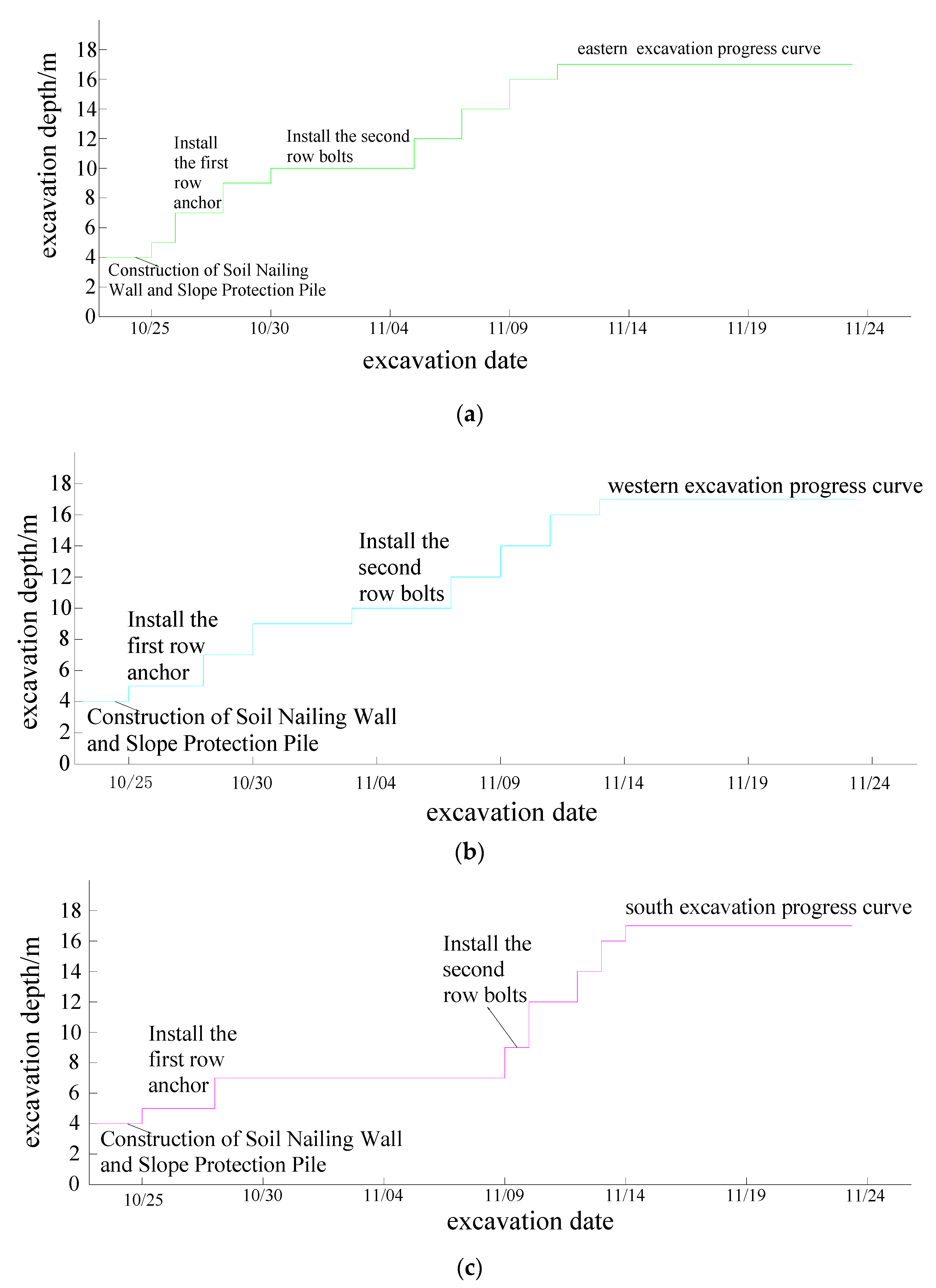

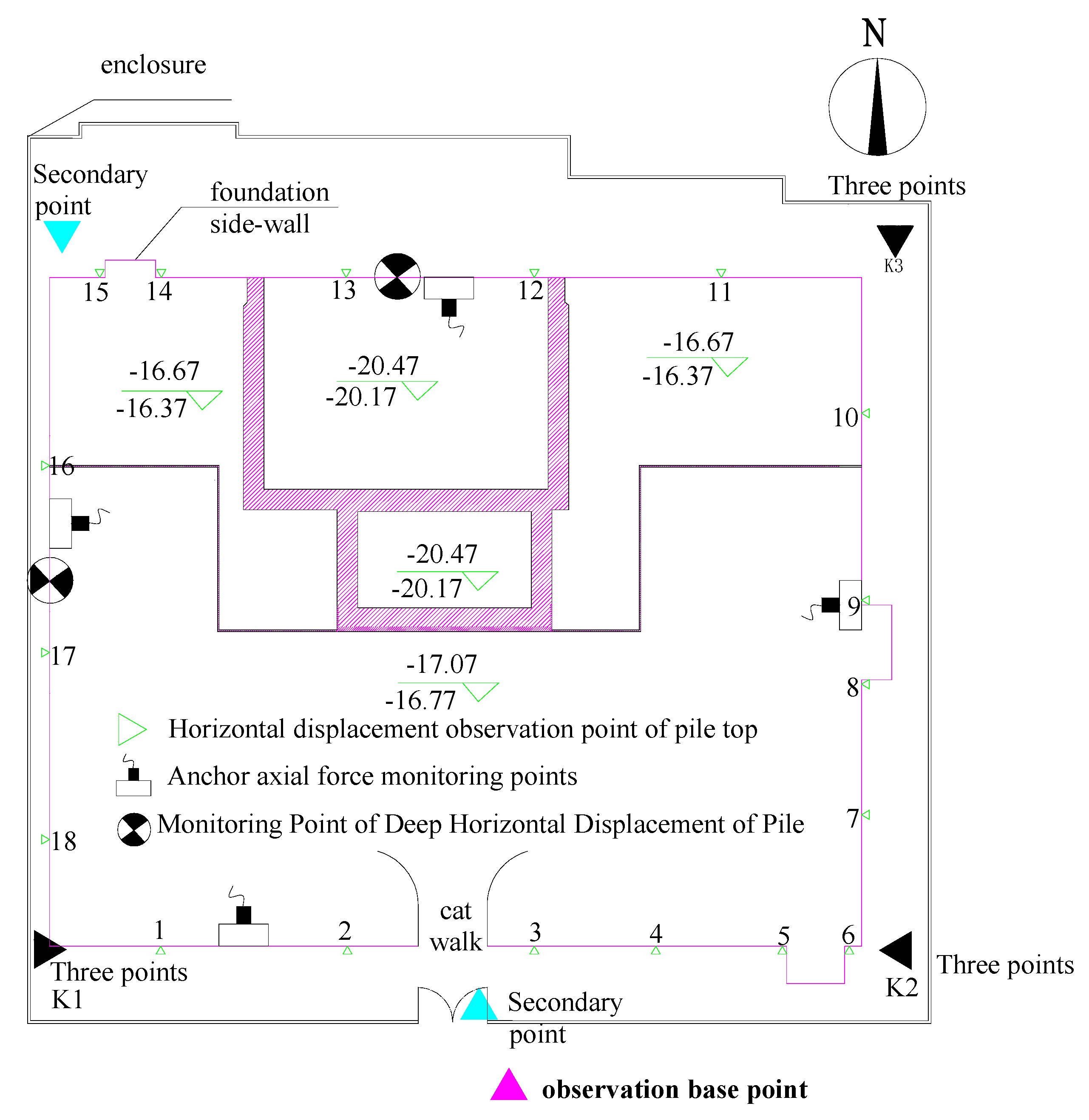
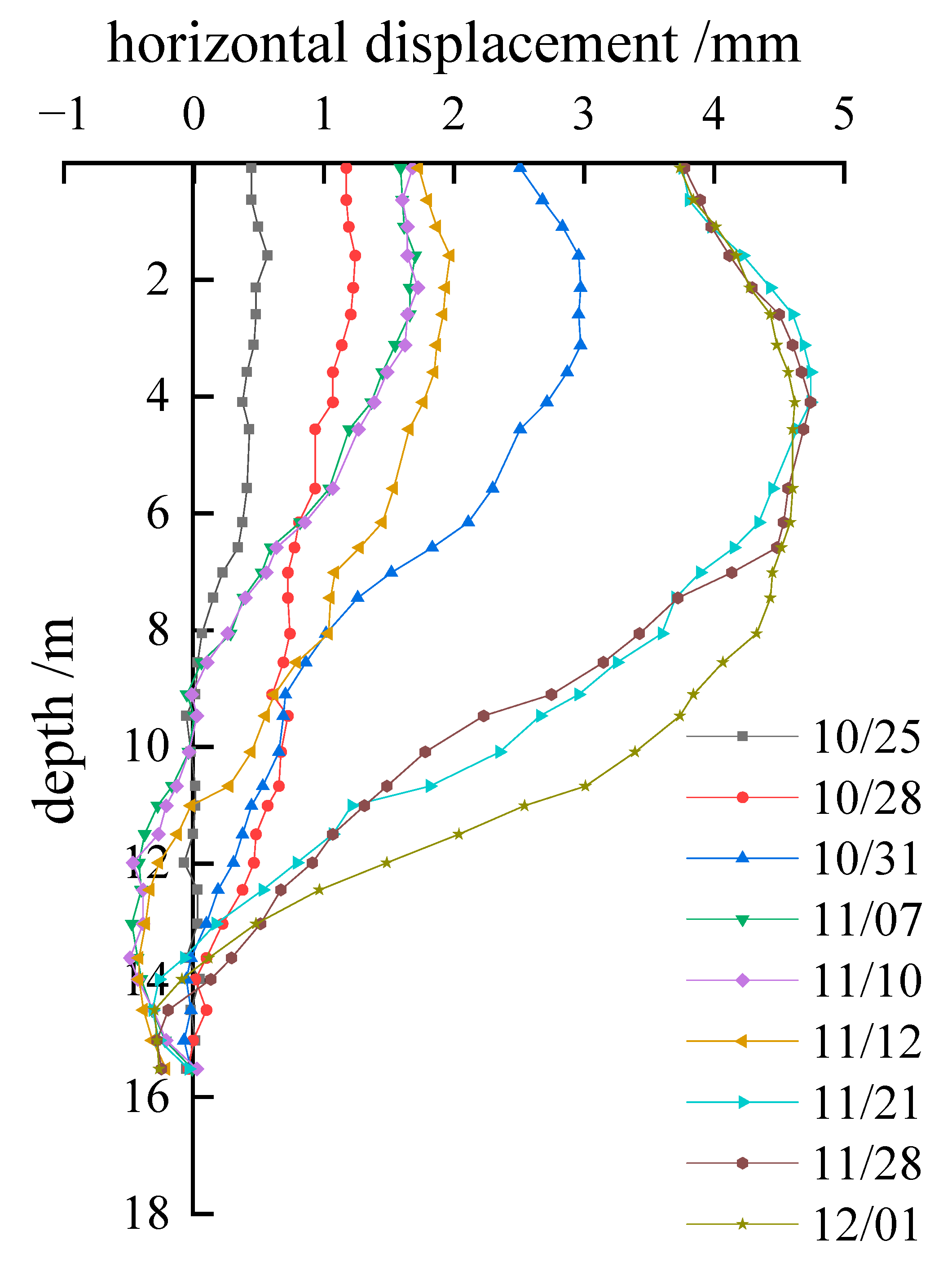

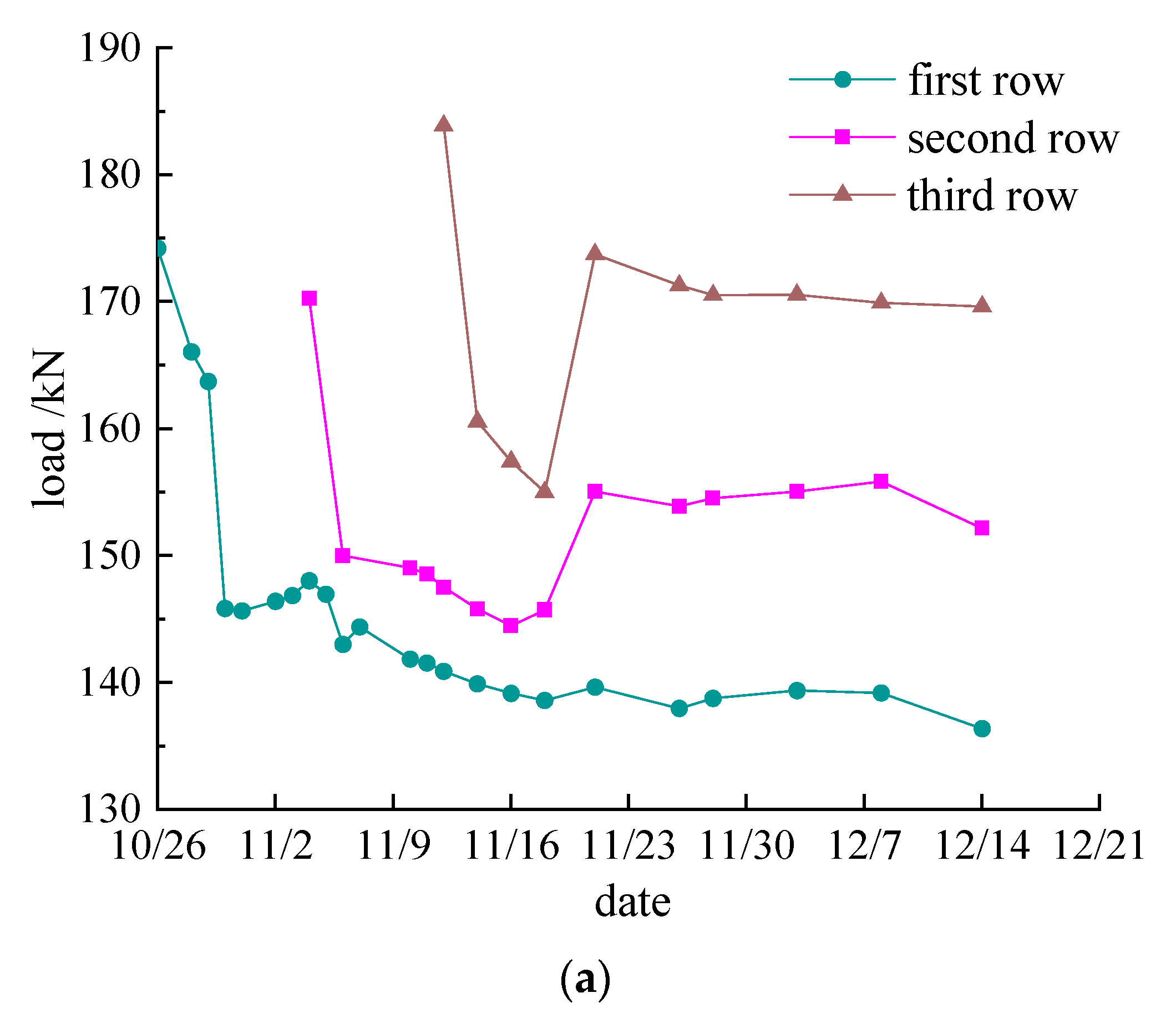
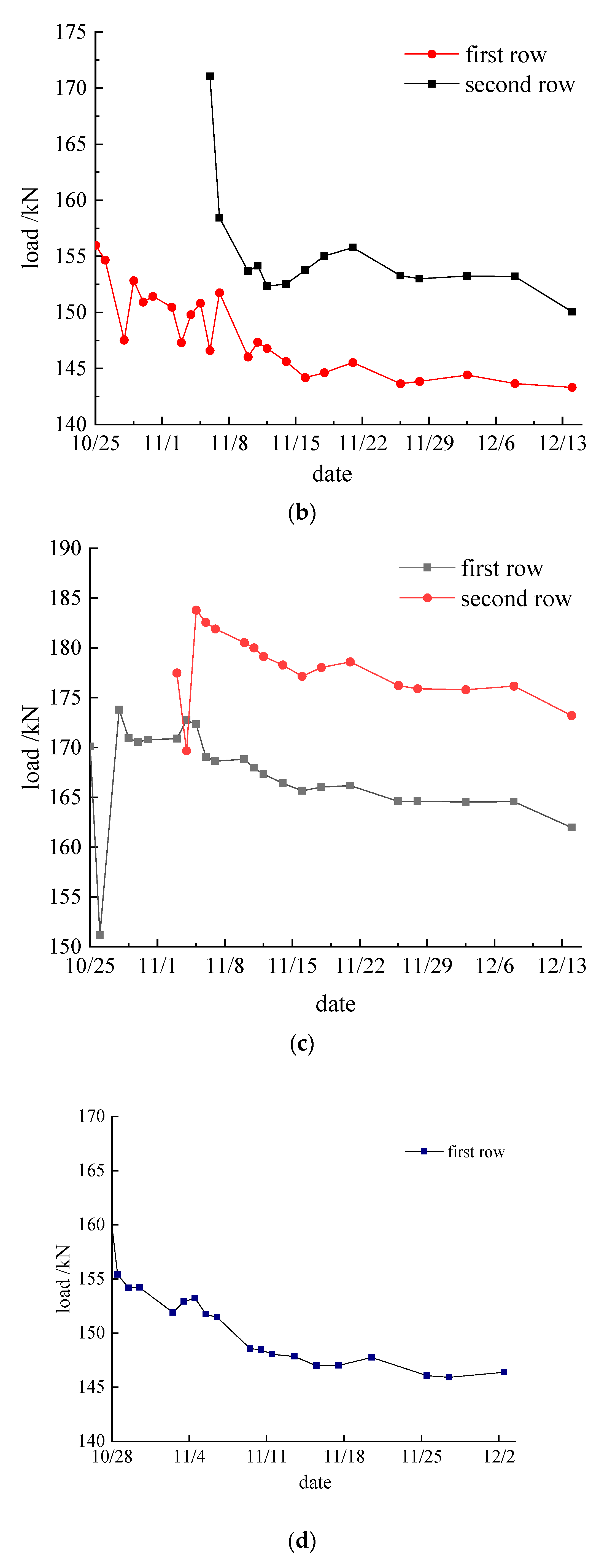
| Level Number | Soil Layer | Thickness/m | γ/kN·m−3 | C/KPa | Φ/° | Modulus of Compression/Mpa | Poisson Ratio |
|---|---|---|---|---|---|---|---|
| 1 | miscellaneous fill | 0.70 | 19.0 | 10.00 | 18.00 | 9.0 | 0.41 |
| 2 | powdery soil | 1.50 | 19.6 | 20.00 | 27.00 | 15.0 | 0.35 |
| 3 | fine sand | 2.80 | 20.0 | 3.00 | 32.00 | 31.0 | 0.32 |
| 4 | pebbles | 9.00 | 20.5 | 0.00 | 45.00 | 40.0 | 0.23 |
| 5 | pebbles | 10.00 | 21.0 | 3.00 | 50.00 | 50.0 | 0.19 |
| Serial Number | Purpose | Building Floors | Foundation Depth | Distance to Foundation Pit/m | Load Concentration/kpa |
|---|---|---|---|---|---|
| ① | current residence | 4 | 0.50 | 22.80 | 80 |
| ② | current residence | 4 | 0.50 | 22.80 | 80 |
| ③ | current residence | 2 | 0.50 | 11.30 | 40 |
| ④ | current residence | 10 | >10.00 | 20.40 | 160 |
| ⑤ | guest house | 6 | 3.50 | 9.00 | 120 |
| ⑥ | guest house | 4 | 3.50 | 6.00 | 80 |
| ⑦ | guest house | 6 | 3.50 | 6.00 | 120 |
| Serial Number | Type of Anchor | Horizontal Spacing/m | Vertical Spacing/m | Angle of Incidence/° | Overall Length/m | Rod Diameter/mm | Anchorage Section/m | Prestress/kN |
|---|---|---|---|---|---|---|---|---|
| 1 | soil nailingΦ16 | 1.60 | 1.50 | 10 | 5.5 | 130 | ||
| 2 | soil nailingΦ16 | 1.60 | 1.50 | 10 | 4.5 | 130 | ||
| 3 | strand3 × 7Φ5 | 1.60 | 4.30 | 15 | 21 | 150 | 14 | 360 |
| 4 | strand3 × 7Φ5 | 1.60 | 6.00 | 15 | 13 | 150 | 7 | 330 |
| Pile Type | Pile Length/m | Pile Spacing/m | Pile Diameter/m | Embedded Depth/m | Concrete Strength | Main Reinforcement | Hooped Reinforcement | Prestressed Strands Rounding the Opening |
|---|---|---|---|---|---|---|---|---|
| manual excavation pile | 16.4 | 1.60 | 0.8 | 3.5 | C25 | 12Φ20 | Φ14@2000 | φ6.5@200 |
| Serial Number | Position | Sectional Dimension/mm | Main Reinforcement | Prestressed Strands Rounding the Opening | Concrete Strength |
|---|---|---|---|---|---|
| 1 | top beam | 900 × 500 | 8Φ20 | φ6.5@200 | C35 |
| 2 | middle beam | 25Btwin-i girder |
| Hierarchical Load/kN | Stability Time (Sand Layer)/min | Rate of Loading/(kN·min−1) |
|---|---|---|
| 0.1 Nt~0.2 Nt | 2 | ≤100 |
| 0.5 Nt | 5 | ≤100 |
| 0.75 Nt | 5 | ≤100 |
| Hydraulic Gauge Readings/Mpa | Theoretical Load/kN | Measured Load/kN | Hydraulic Gauge Readings/Mpa | Theoretical Load/kN | Measured Load/kN | Hydraulic Gauge Readings/Mpa |
|---|---|---|---|---|---|---|
| 2 | 36 | 32.5 | 14 | 252 | 206.37 | 2 |
| 4 | 72 | 37.78 | 12 | 216 | 204.51 | 4 |
| 1.6 | 28.8 | 30.96 | 10 | 180 | 202.5 | 1.6 |
| 10 | 180 | 94.61 | 8 | 144 | 201.34 | 10 |
| 15 | 270 | 147.92 | 6 | 108 | 198.19 | 15 |
| 20 | 360 | 208.15 | 4 | 72 | 191.93 | 20 |
| 18 | 324 | 207.69 | 2 | 36 | 189.14 | 18 |
| 16 | 288 | 206.91 | 0 | 36 | 177.56 | 16 |
Publisher’s Note: MDPI stays neutral with regard to jurisdictional claims in published maps and institutional affiliations. |
© 2022 by the authors. Licensee MDPI, Basel, Switzerland. This article is an open access article distributed under the terms and conditions of the Creative Commons Attribution (CC BY) license (https://creativecommons.org/licenses/by/4.0/).
Share and Cite
Sun, Y.; Li, Z. Study on Design and Deformation Law of Pile-Anchor Support System in Deep Foundation Pit. Sustainability 2022, 14, 12190. https://doi.org/10.3390/su141912190
Sun Y, Li Z. Study on Design and Deformation Law of Pile-Anchor Support System in Deep Foundation Pit. Sustainability. 2022; 14(19):12190. https://doi.org/10.3390/su141912190
Chicago/Turabian StyleSun, Yongshuai, and Zhiming Li. 2022. "Study on Design and Deformation Law of Pile-Anchor Support System in Deep Foundation Pit" Sustainability 14, no. 19: 12190. https://doi.org/10.3390/su141912190





